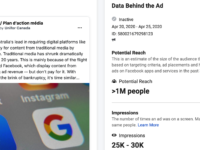Earlier this week, I posted on the lobbying campaign of News Media Canada, the group representing the major Canadian news media publishers, to call for the creation of a government digital media regulatory agency that would have the power to establish mandated payments for linking to news articles on social media sites, establish what content is prioritized on those sites, and potentially issue fines in the hundreds of millions of dollars. The report inaccurately describes the proposed Australian approach upon which it is modelled, avoids acknowledging that payments would be for links, and would open the door to hundreds of millions on tariff retaliation.
Archive for October, 2020
Where is Canada’s News Media Lobby Promoting Its Link Licensing Plan for Facebook? On Facebook
Last week, News Media Canada, the lobby group representing the major Canadian news media publishers, released a report calling for the creation of a government digital media regulatory agency that would have the power to establish mandated payments for linking to news articles on social media site, establish what content is prioritized on those sites, and potentially issue fines in the hundreds of millions of dollars. As I noted in my review of the report, it inaccurately describes the proposed Australian approach upon which it is modeled, avoids acknowledging that payments would be for links, and would open the door to hundreds of millions on tariff retaliation by the US under the USMCA.
The report was widely covered by the publishers promoting it: the National Post devoted its front page to the report, the other Postmedia papers all found time to cover the release, and the Toronto Star ran multiple articles and opinion pieces on it. In addition to the front page of some newspapers, the papers themselves posted the stories on Facebook, often multiple times. For example, the National Post front page story was posted 11 times by Postmedia papers including posts from the National Post (twice), Calgary Herald, Ottawa Citizen, Montreal Gazette, Edmonton Journal, Windsor Star, London Free Press, Vancouver Sun, Regina Leader-Post, and Saskatchewan StarPhoenix. The National Post also ran a story in the Financial Post on the report which posted on Facebook, a Diane Francis opinion piece on the report which it posted on Facebook, and a story on what happens when a local newspaper dies, which it posted twice on Facebook. In fact, just this morning, there is yet another op-ed in support of the report by Jerry Dias, which appears in both the National Post and Ottawa Citizen, with both immediately posting to Facebook.
The LawBytes Podcast, Episode 67: Tamir Israel on Facial Recognition Technologies at the Border
Facial recognition technologies seem likely to become an increasingly commonplace part of travel with scans for boarding passes, security clearance, customs review, and baggage pickup just some of the spots where your face could become the source of screening. Tamir Israel, staff lawyer at CIPPIC, the Samuelson-Glushko Canadian Internet Policy and Public Interest Clinic at the University of Ottawa, recently completed a major study on the use of facial recognition technologies at the border. He joins me on the LawBytes podcast to discuss the current use of the technologies, how they are likely to become even more ubiquitous in the future, and the state of Canadian law to ensure appropriate safeguards and privacy protections.
Canadian News Media Lobby Group Calls for Creation of Government Digital Media Regulatory Agency
News Media Canada (NMC), the lobby group representing the major newspaper publishers in Canada, released a new report yesterday calling for the creation of a government digital media regulatory agency that would have the power to establish mandated payments for linking to news articles, establish what content is prioritized on social media sites, require companies to disclose algorithmic changes, hand over moderation control of content on news stories to the publishers, and potentially issue fines in the hundreds of millions of dollars. Canadian Heritage Minister Steven Guilbeault has made “get money from web giants” his top legislative priority and has expressed support for mandated licensing for links.
The report, which inaccurately describes the ill-advised Australian approach to licensing links to news articles, is notable for many of the things it does not say. For example, one could easily read the 41 page report and not realize that companies such as Google and Facebook do not publish full versions of news articles without a licence. Indeed, rather than “taking” content, links to news articles are posted by their users, which then send interested readers back to the original source. In fact, the media companies themselves are typically responsible for posting their own articles and granting a licence for their use.
How Can Linking to an Article be Immoral When the Media Source Itself Does the Posting, Part 2: A Day in the Life of the Toronto Star on Facebook
Canadian Heritage Minister Steven Guilbeault, who says his top legislative priority is to “get money from web giants”, has discussed creating a new mandated licence for social media linking to news articles. Guilbeault calls the practice “immoral” and envisions using the Copyright Board of Canada to create a tariff for linking to news articles accompanied by new government powers to levy penalties for failure to comply. Last week, I looked at a single Toronto Star article to see its engagement on Facebook. Using the CrowdTangle Chrome extension, I found that virtually all public engagement with the article came from a Facebook post that the Toronto Star posted itself.
Today’s post expands on that approach by examining a larger group of articles all taken from single day. This post looks at 36 original articles posted to the Star’s website on the morning of October 14, 2020. The day was selected at random and while most Facebook posts take place within the first 24 hours, I waited five days before examining the social media engagement with the articles to give time for potential posts and shares. The Star’s website changes throughout the day, so recreating the day’s paper is difficult. Instead, I endeavoured to include all new Toronto Star-originated articles that had been posted over the prior 20 hours (thereby including articles posted on both October 13th and the morning of the 14th). Articles from wire news services (which is the majority of foreign news stories, sports stories, and some national stories) were excluded as they are licensed by the Star and can be found from many sources online.











